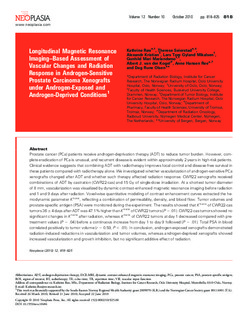| dc.contributor.author | Røe, Kathrine | |
| dc.contributor.author | Seierstad, Therese | |
| dc.contributor.author | Kristian, Alexandr | |
| dc.contributor.author | Mikalsen, Lars Tore G | |
| dc.contributor.author | Mælandsmo, Gunhild | |
| dc.contributor.author | van der Kogel, Albert | |
| dc.contributor.author | Ree, Anne Hansen | |
| dc.contributor.author | Olsen, Dag Rune | |
| dc.date.accessioned | 2015-03-31T14:26:51Z | |
| dc.date.accessioned | 2016-10-21T14:24:37Z | |
| dc.date.available | 2015-03-31T14:26:51Z | |
| dc.date.available | 2016-10-21T14:24:37Z | |
| dc.date.issued | 2010 | |
| dc.identifier.citation | Neoplasia 2010, 12(10):818-825 | nb_NO |
| dc.identifier.issn | 1476-5586 | |
| dc.identifier.uri | http://hdl.handle.net/11250/2417032 | |
| dc.description.abstract | Prostate cancer (PCa) patients receive androgen-deprivation therapy (ADT) to reduce tumor burden. However, complete eradication of PCa is unusual, and recurrent disease is evident within approximately 2 years in high-risk patients. Clinical evidence suggests that combining ADT with radiotherapy improves local control and disease-free survival in these patients compared with radiotherapy alone. We investigated whether vascularization of androgen-sensitive PCa xenografts changed after ADT and whether such therapy affected radiation response. CWR22 xenografts received combinations of ADT by castration (CWR22-cas) and 15 Gy of single-dose irradiation. At a shortest tumor diameter of 8 mm, vascularization was visualized by dynamic contrast-enhanced magnetic resonance imaging before radiation and 1 and 9 days after radiation. Voxel-wise quantitative modeling of contrast enhancement curves extracted the hemodynamic parameter Ktrans, reflecting a combination of permeability, density, and blood flow. Tumor volumes and prostate-specific antigen (PSA) were monitored during the experiment. The results showed that Ktrans of CWR22-cas tumors 36±4 days after ADT was 47.1% higher than Ktrans of CWR22 tumors (P = .01). CWR22-cas tumors showed no significant changes in Ktrans after radiation, whereas Ktrans of CWR22 tumors at day 1 decreased compared with pretreatment values (P = .04) before a continuous increase from day 1 to day 9 followed (P = .01). Total PSA in blood correlated positively to tumor volume (r = 0.59, P < .01). In conclusion, androgen-exposed xenografts demonstrated radiation-induced reductions in vascularization and tumor volumes, whereas androgen-deprived xenografts showed increased vascularization and growth inhibition, but no significant additive effect of radiation. | nb_NO |
| dc.language.iso | eng | nb_NO |
| dc.rights | Attribution-NonCommercial-NoDerivs CC BY-NC-ND | |
| dc.rights.uri | http://creativecommons.org/licenses/by-nc-nd/3.0/ | |
| dc.title | Longitudinal magnetic resonance imaging-based assessment of vascular changes and radiation response in androgen-sensitive prostate carcinoma xenografts under androgen-exposed and androgen-deprived conditions | nb_NO |
| dc.type | Journal article | nb_NO |
| dc.type | Peer reviewed | |
| dc.date.updated | 2015-03-31T14:26:51Z | |
| dc.subject.nsi | VDP::Medisinske fag: 700::Klinisk medisinske fag: 750::Onkologi: 762 | nb_NO |
| dc.subject.nsi | VDP::Midical sciences: 700::Clinical medical sciences: 750::Oncology: 762 | nb_NO |
| dc.identifier.doi | 10.1593/neo.10484 | |
| dc.identifier.cristin | 796659 | |

